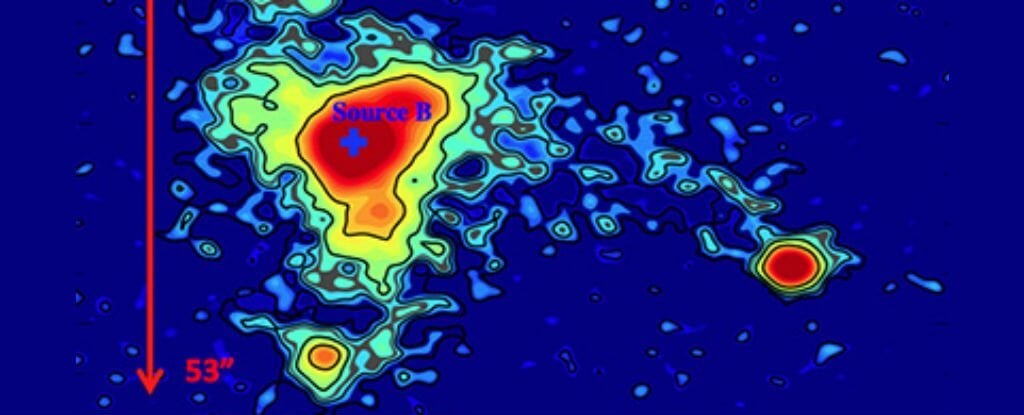- Get link
- X
- Other Apps

Astronomers are faced with a rather interesting case. In one of the distant corners of the Universe, a huge luminous gas bubble was found, and scientists cannot explain what exactly causes its glow. The discovered nebula is located in the center of a giant “protocluster” located approximately 10 billion light-years from Earth and consisting of one of the oldest galaxies in the Universe. According to astronomers, the found object is the brightest among the previously found space objects of this type.
The find that falls under the class of so-called “giant Lyman-alpha nebulae” (enormous Lyman-alpha nebula, ELAN) is not only the brightest object of this type in the Universe, but also the largest. It even surpasses the “Slug” nebula, discovered in 2014 and stretching more than 2 million light years.
“It is incredibly bright and, most likely, even larger than the Slug nebula, but we couldn’t find anything except the blurred outlines of galaxies inside it,” said Javier Prochaska, one of the researchers at the University of California at Santa Cruz.
"In other words, we have found an incredible size energy phenomenon, but we cannot yet detect the source of its energy."
To date, scientists have known only a few objects of the ELAN class, but researchers believe that they are part of the so-called cosmic web, which entangles the entire Universe and interconnects the galaxies. However, while the source of luminescence of other giant Lyman-alpha nebulae is most often an incredible level of radiation, created, as a rule, by quasars, new stars and supernovae inside them, similar objects as part of the study of the new nebula, called MAMMOTH-1, scientists found no. Therefore, researchers can not figure out what exactly gaseous hydrogen in the nebula causes the Lyman-alpha radiation (characteristic radiation of hydrogen atoms) to glow.
Interestingly, scientists already faced a similar problem in 2000, when another ELAN object was discovered, called the “Lyman-alpha 1 bubble”. It is located in the southern part of the constellation "Aquarius" approximately 11.5 billion years from Earth. The size of this nebula is three times the size of our Milky Way galaxy. But despite the fact that it “burns” with bright green color in astronomers' telescopes, until today, scientists have not been able to determine the source of its luminescence.
According to one of the latest assumptions, the source of this glow of such objects can be supermassive black holes, absorbing the matter of galaxies located in the central region of the nebula. In a new study MAMMOTH-1, scientists have come to the same conclusion.
The nebula itself was discovered as part of a new sky survey Mapping the Most Massive Overdensities Through Hydrogen (MAMMOTH), within which the Slug nebula was also discovered. Discovered inside the nebula, the protocluster is incredibly huge (about 50 light-years) and contains an unusually dense concentration of galaxies interconnected by powerful gravity.
Despite the fact that by now all these galaxies are very old, through telescopes they look to us as young and appeared just 3 billion years after the Big Bang. Several hypotheses were proposed on what could cause such a bright glow of the entire MAMMOTH-1 nebula and its protocluster inside, but the most likely answer to this question could most likely be related to the so-called “active galactic core”. At least this is what the current group of scientists who studied the detected nebula thinks so.
The active galactic core is a compact region of space in the center of galaxies and, as a rule, has a much higher level of luminosity than anything else. Scientists explain this by the fact that one of the sources of the active galactic nucleus are supermassive black holes, actively absorbing the gas in the center of the galaxy. The intense radiation of the active galactic nucleus ionizes the hydrogen around it, and this, quite possibly, causes the ELAN to emit such a bright Lyman-alpha glow.
Observations show that most often the source of the brightest active galactic nuclei in visible light are quasars — the brightest objects in the Universe — but in the case of the MAMMOTH-1 nebula no quasars were found. Although, of course, no one excludes the possibility that behind a dense accumulation of gas and dust of a nebula one could still hide.
“There is a suspicion of a similarity with the active galactic core, but we did not find any direct evidence on the optical images. I think it could be some kind of quasar, hidden behind a very dense accumulation of dust, which closes a greater amount of light from us, ”Prochaska comments.
The team of researchers, of course, will try to make out at least one quasar at a distance of about 10 billion light years from Earth, but at the moment the source of the glow of this ELAN remains a complete mystery to them.
The article is based on materials .
- Get link
- X
- Other Apps
Comments
Post a Comment